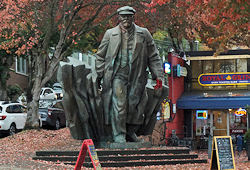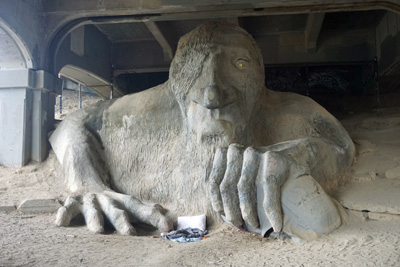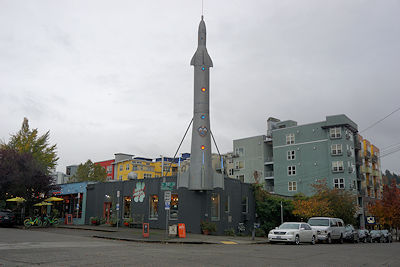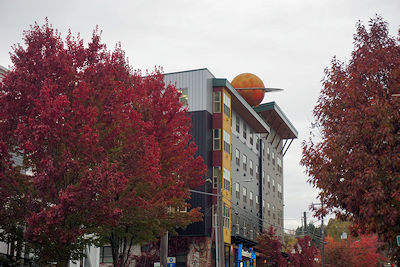
At the 1994 Fremont Fair, residents of the Washington state neighborhood voted overwhelmingly – 784 to 17 – to secede from the city of Seattle and both establish the Artists Republic of Fremont and proclaim itself as the “Center of the Universe” instead.
The seeds of that secession were planted in 1979 when sculptor Richard Beyer created Waiting for the Interurban and installed the life-size creation at the corner of Fremont Avenue and North 34th Street. The sculpture depicts six people under a shelter waiting for a light rail train that once connected downtown Seattle with its various neighborhoods, and represented the isolation and independence of Fremont from the larger city that sits across the Lake Washington Ship Canal.
The secession movement picked up steam in 1991 when a group of Fremont scientists concluded that the “Center of the Universe” was located at the intersection of North Fremont Avenue and 35th Street North. Part of their reasoning pertained to an already existing directional sign marking the distance to everything from the Louvre Museum in France to the Milky Way. A night of heavy drinking likewise influenced their calculations, as well as the fact that such an assertion could neither be proved or disproved.
While Fremont was unable to legally secede from Seattle, the Metropolitan King County Council officially declared in 1994 that the Artists Republic of Fremont existed as an Independent ImagiNation nonetheless. “A myriad of magical and merry artistic pursuits hath sprung to lusty life amid the Fremontian foam and fomentations,” the decree stated. “To wit, the quiet crowd that waits cemented in eternity for the bus that no more comes; and the droll troll that lurks in the shadow of the great bridge hovering above the kingdom, guarding the hall of giants.”
The proclamation was obviously whimsical in nature, but then again, so is Fremont itself. Once the epicenter of the counterculture movement of the 1960s, present-day Fremont is still a haven for artists despite the inevitable gentrification of recent years. To highlight its continued independence and allegiance to that spirit, a series of public art statues, murals, and topiary dot the neighborhood, truly making Fremont a “myriad of magical and merry artistic pursuits.”
While Waiting for the Interurban may have been the earliest, it is far from the only one to gain notoriety. In 1989, the Fremont Arts Council held a competition to reclaim an area under the Aurora Bridge that had become a dumping ground and preferred location for drug dealers. Sculptor Steve Badanes won the contest and constructed a two-ton, eighteen-foot-tall troll. Inspired by the folktale Three Billy Goats Gruff, the Fremont Troll is depicted with half its body emerging from the ground as one of its hands crushes an actual Volkswagen Beetle.
Three Billy Goats Gruff is not the only fairy tale that inspired artwork in Fremont. Gazing from the top floor of a control tower at the base of the Fremont Bridge is a neon Rapunzel – replete with electric hair flowing down the side of the building – while a window on the opposite side contains a neon elephant and crocodile in honor of Rudyard Kipling’s The Elephant’s Child.
When it was announced in 1991 that a 1950s Cold War rocket fuselage previously displayed in nearby Belltown was going to be dismantled, the Fremont Business Association immediately jumped into action and secured the rocket for Fremont. The original design complicated the rocket’s installation but a group of artists reconfigured it with new fins and nose cones to make it fit its new home – the top of a building located at the corner of North 35th Street and Evanston Avenue North. In addition to the Fremont coat-of-arms painted on the side, the rocket’s fuselage also contains the motto De Libertas Quirkas, which translates into “Freedom to Be Peculiar.”
The Fremont public art scene also contains a mother and baby Apatosaurus. The pair are clipped shrubs – more commonly called topiaries – and were originally created to promote a dinosaur exhibit at the nearby Pacific Science Center. Once the exhibition closed, Fremont activists Josh Logan and Jon Hegeman purchased the mother and baby Apatosaurus for one dollar. They then moved the dinosaurs from their original location in downtown Seattle with the assistance of other members of the neighborhood. Now located at the intersection of Phinney Avenue North, North 34th Street, and North Canal Street, the topiaries are regularly cared for by the Fremont Rotary Club.
Arguably the most notorious public art display in Fremont is the seven ton, sixteen-foot-tall statue of Vladimir Lenin – the communist leader of the Russian Revolution and founder of the Soviet Union – that sits at the intersection of Fremont Place North, North 36th Street, and Evanston Avenue North. The statue was commissioned in 1981 by the Communist Party of Czechoslovakia. Instead of depicting Lenin in the traditional manner of holding a book, sculptor Emil Venkovn portrayed him as a violent revolutionary leader rather than philosopher educator. The statue was completed in 1988 but then torn down the following year after the fall of Communism.
English teacher Lewis Carpenter later discovered the monument in a Czech scrapyard. Recognizing its artistic merit and bold depiction, he purchased the sculpture and brought it back to the United States. He originally intended to open an ethnic restaurant in the Seattle region with the statue standing at its entrance, but died in a car accident in 1994 before his plans were completed. The Fremont Chamber of Commerce agreed to display the statue on behalf of Carpenter’s family until it could be sold – no buyer was ever found and the Lenin Statue instead became a permanent fixture in Fremont.
Although many have decried the public display of a communist revolutionary, the citizens of Fremont see the statue as an expression of artistic freedom instead. Any political undertones are further diluted when Lenin is draped with Christmas lights over the holiday season and dressed in a tutu during Pride festivities in the neighborhood.
“The Artistic Republic of Fremont is hereby declared, decreed, and determined to be an Independent ImagiNation and a Mecca for those of independent minds and spirits, and is forever and fervently empowered with all the rights and privileges thereto accruing,” the Metropolitan King County Council proclaimed in 1994. “Further, the Metropolitan King County Council plainly postulates and proclaims Fremont to be Center of the Universe, indeed, and hereby supports Fremont in its gallant endeavors to apply to the United Nations for sovereign status under international law.”
Fremont never actually petitioned the United Nations for those sovereignty rights, but with over one dozen murals, statues, and topiaries making up the public art scene within the Seattle community – including Cold War relics, fairytale heroines, dinosaurs, and trolls – it is hard to argue that Fremont isn’t its own whimsical nation nonetheless.
Anthony Letizia





